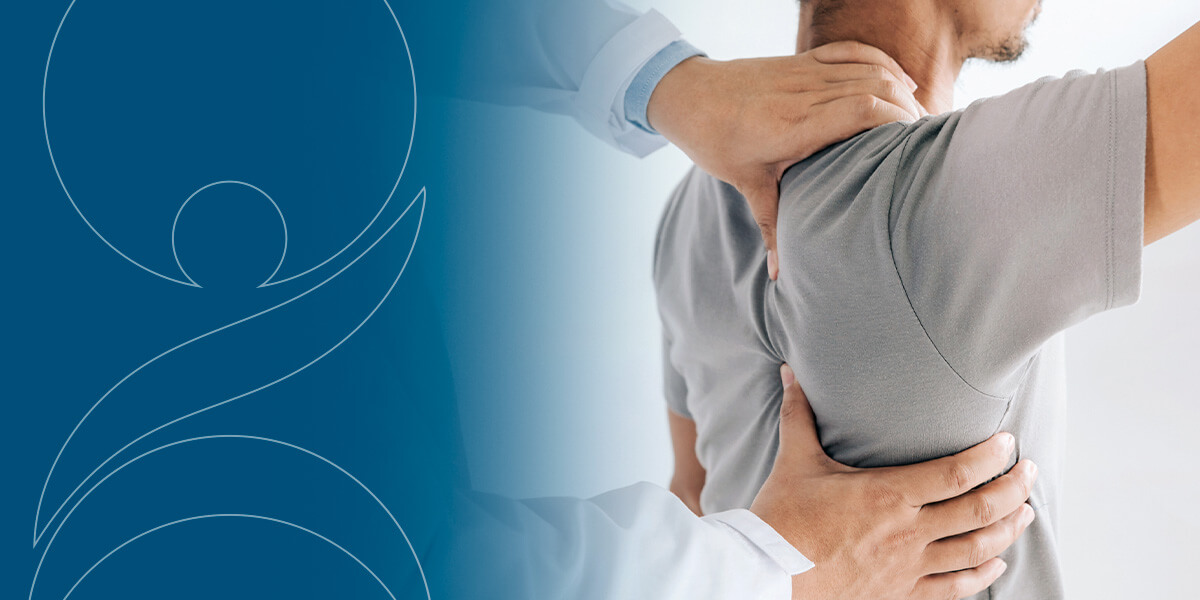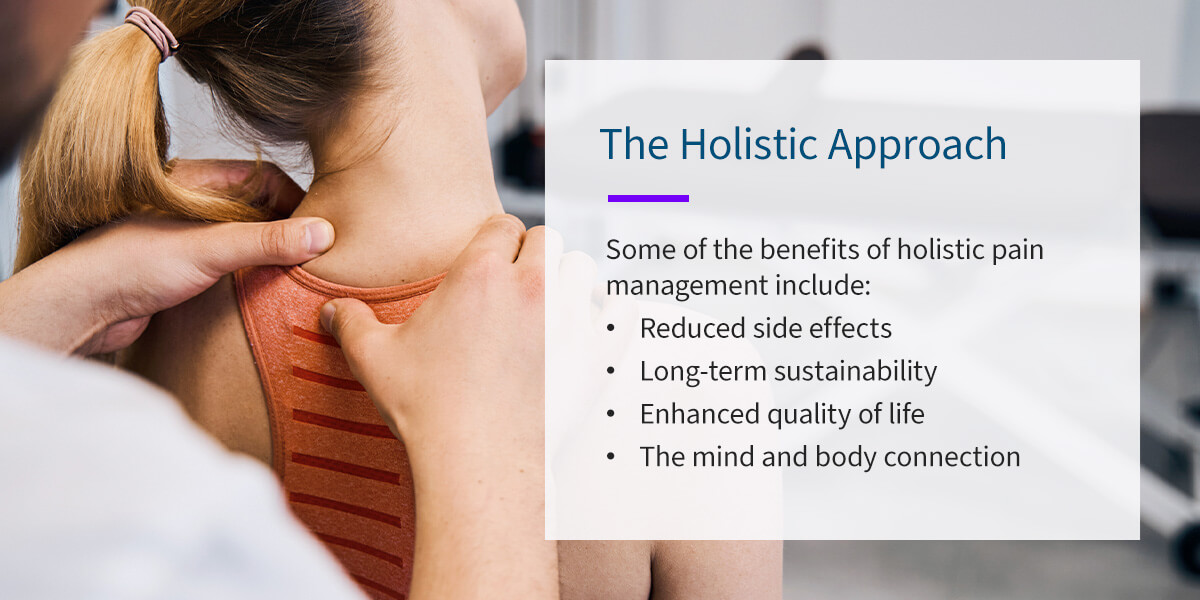Pain is a universal experience that touches the lives of countless individuals — 50 million in the US alone. Pain demands our attention, whether it’s the persistent ache of chronic conditions, the sudden jolt of an injury or the wear and tear of everyday life. It can be an unwelcome companion that disrupts daily routines, impedes quality of life and tests the boundaries of endurance.
It’s natural to seek solutions that promise quick fixes, often through medication alone. Pain is a complex interplay of biological, psychological and emotional factors. A holistic approach to pain management could be a potential long-term solution.
Understanding Pain
Recognizing the differences between acute and chronic pain, understanding the physiological processes involved and acknowledging the emotional aspects are the first elements in crafting a holistic approach to pain management.
Acute vs. Chronic
Pain is commonly categorized into two main types — acute and chronic:
- Acute pain: This type is typically short-lived and serves as a warning signal. It arises suddenly in response to an injury or illness and usually subsides once the underlying issue is resolved. Acute pain can be intense, but it tends to diminish over time.
- Chronic pain: In contrast, chronic pain persists for an extended period, often lasting months or even years. It may result from an underlying medical condition or injury, but it outlasts the expected healing time. Chronic pain can significantly impact one’s quality of life, leading to physical and psychological distress.
The Physiology of Pain
Pain signals are transmitted through specialized nerve fibers that detect tissue damage or injury. These signals travel to the brain, where they are processed and interpreted.
Pain is not solely physical. It also has emotional and psychological components. The brain’s emotional centers can amplify or dampen the perception of pain. Factors like anxiety, stress and depression can intensify the experience of pain, making it crucial to address both the physical and emotional aspects of holistic pain management.
One of the challenges of pain management is its invisibility. Unlike a visible wound or injury, pain cannot be seen by others, leading to misunderstandings and skepticism. This is particularly important for loved ones and caregivers to understand when supporting someone in distress. Just because pain isn’t visible doesn’t mean it isn’t real or debilitating.
The Holistic Approach
Instead of focusing solely on symptom relief through medication, holistic pain management addresses pain as a multifaceted experience involving the body, mind and spirit. It emphasizes the interconnectedness of well-being to achieve lasting relief and improved quality of life.
Holistic methods recognize that treating the whole person is often more effective than addressing symptoms in isolation. Some of the benefits of holistic pain management include:
- Reduced side effects: Unlike some medications that can come with a range of side effects, holistic approaches typically have minimal or no adverse effects. This is especially beneficial for individuals sensitive to medication or wishing to avoid potential complications.
- Long-term sustainability: Holistic methods focus on creating sustainable, long-term solutions rather than providing temporary relief. By addressing the root causes of pain and incorporating lifestyle changes, individuals can often reduce the recurrence of pain episodes.
- Enhanced quality of life: Holistic pain management alleviates pain and improves overall well-being. It fosters a sense of control and empowerment over one’s health, leading to a higher quality of life.
- The mind and body connection: Emotional and psychological factors can influence pain perception. Stress, anxiety and depression can exacerbate pain, while relaxation, meditation and positive thinking can help alleviate it.
Combining Complementary Therapies
Holistic pain management often integrates complementary therapies to address pain from multiple angles. Some of these therapies include:
- Physical therapy: Designed to improve mobility, reduce pain and enhance physical function, physical therapy is a cornerstone of holistic pain management.
- Massage therapy: Massage can alleviate muscle tension, improve blood flow and promote relaxation, all contributing to pain relief.
- Yoga and Tai Chi: These mind-body practices combine physical postures, breathing exercises and meditation to enhance flexibility, balance and overall well-being.
- Chiropractic: Upper cervical chiropractors can also relieve pain and be a gentle complementary therapy for chronic pain patients.
Creating Your Pain Management Plan
Pain management is not a one-size-fits-all solution. You need a personalized plan considering your unique circumstances, goals and preferences to address your pain effectively. Crafting a comprehensive pain management plan involves several key steps, each crucial for relief and improved quality of life. Learn what a pain management plan comprises in the following sections:
Diagnosis and Assessment
The foundation of any effective pain management plan is a clear and accurate diagnosis. This step clears the way to understanding the underlying causes of your pain and tailoring your treatment accordingly. Here’s what you need to know:
- Consult health care professionals: Begin by consulting with professionals specializing in pain management. This may include your primary care physician, pain specialists, orthopedists, neurologists or other relevant specialists.
- Diagnostic tests and procedures: Your health care team may recommend various diagnostic tests and techniques, such as X-rays, MRI scans, blood tests or nerve conduction studies. These tests help identify the source and nature of your pain.
- Medical history: Be prepared to provide a detailed medical history, including any prior injuries, surgeries or chronic conditions. Your medical record is valuable in determining the root causes of your pain.
Setting Clear Goals
Establishing goals provides a roadmap for your journey to pain relief. Consider the following:
- Pain reduction: Determine the level of pain reduction you aim to achieve. For example, you might aim to reduce your pain from an eight on a pain scale to a five within three months.
- Functional improvement: Consider how pain affects your daily life and set goals to improve functionality. This could involve purposes related to mobility, sleep or the ability to perform specific tasks.
- Medication reduction: If you use medication, you might set goals to reduce reliance on pain medications over time.
Building Your Support Network
Managing pain after surgery can be challenging, both physically and emotionally. A robust support network can make a significant difference in your pain management journey. Here’s how to build and leverage your support system:
- Family and friends: Share your pain management goals and challenges with loved ones. Their understanding and support are invaluable.
- Support groups: Consider joining a pain management support group in person or online. These groups provide a platform for sharing experiences and coping strategies with individuals facing similar challenges.
- Therapy: Cognitive-behavioral therapy (CBT) or other forms of counseling can help you manage the emotional aspects of pain and develop effective coping strategies.
Exploring Holistic Techniques
Holistic pain management encompasses many techniques and practices beyond traditional medicine. Combining holistic with traditional strategies can offer advanced pain management that should yield results. Some of these methods include:
- Physical therapy: Tailored exercises and stretches to improve mobility and reduce pain.
- Mindfulness and relaxation: Techniques such as meditation, deep breathing and progressive muscle relaxation to manage stress and alleviate pain.
- Diet and nutrition: Dietary adjustments can play a significant role in reducing inflammation and pain. Consult a nutritionist or dietitian for personalized guidance.
- Lifestyle changes: Healthy lifestyle choices, including regular exercise, adequate sleep and stress management, are essential to holistic pain management.
- Complementary therapies: Explore options such as acupuncture, massage therapy and chiropractic care, which can complement your pain management plan.
Tailoring Your Pain Management Care Plan to Your Needs
One of the strengths of holistic pain management is its adaptability. It recognizes that everyone’s pain experience is unique, and treatment plans should be tailored to individual needs. Whether you’re dealing with neuropathic pain, musculoskeletal pain or pain associated with aging, a holistic approach address your specific challenges.
Find Holistic Pain Management Near You
There’s hope beyond medication for those grappling with chronic neck or debilitating back pain. Medication often comes with side effects and doesn’t address the root cause of the pain. At Upper Cervical Chiropractic of New York, you can find experienced upper cervical chiropractors who target the problem area directly.
Whether it’s chronic neck pain that interferes with daily activities or persistent back pain that makes life challenging, our gentle and precise alignment of vertebrae offers a non-pharmaceutical approach to pain relief and treatment.
In collaboration with Upper Cervical Chiropractic of New York, you can embrace a holistic approach to pain management that aligns with your unique needs and fosters a lifetime of wellness.




